Toasted Buckwheat Pilaf with Mushrooms, Broccoli & Scallions
Thanks to Mary Scott, Member-Owner, for sharing this recipe. Mary taught cooking classes through their practice of naturopathy and acupuncture. This is one of Mary’s recipes from their class!
Because we published Mary’s recipe, Mary will receive a $25 gift card to the Co-op. You can win a gift card by sharing your recipe, too. If we publish it, we will give you a gift card! Submit recipes to marketing@peoples.coop anytime!
Give buckwheat a try, then try it again and again. For some, it’s an acquired taste. I like its earthy, nutty and slightly bitter self. It’s amazing with mushrooms, surprisingly delicious with any herbal pesto, and just fine plain with some good quality salt and olive oil or truffle oil if you have that handy. Toast the raw buckwheat in a pan for a few minutes before cooking to deepen the flavor.
A quick growing crop tolerant of a cool and short growing season, here we respect its Eastern European roots by making pilaf with alliums, brassicas and mushrooms. Other combinations from these families would be equally delicious as a winter meal - leeks, romanesco broccoli and cremini mushrooms or shallots, savoy cabbage and dried morel mushrooms come to mind.
Recipe serves 4
Ingredients
1 cup untoasted (raw) buckwheat
2 Tablespoons extra virgin olive oil
2 cups water or vegetable broth
1 onion, diced
4 large cloves garlic, minced
½ pound mushrooms , sliced, to make about 2 cups
2 cups broccoli florets and stems, stems peeled, cut into 1 inch long matchsticks ½ teaspoons sea salt
generous grind of black pepper
2 scallions , thinly sliced or 1/4 cup minced dill leaves
½ cup walnuts, lightly toasted
¼ cup cashew spread (optional)
Method
Place buckwheat into a heavy skillet and toast over medium heat, tossing or swirling every few minutes, until you smell a nutty aroma and see golden brown buckwheat.
Bring water or broth to a boil and hold off heat on the stove.
While buckwheat is toasting, gently warm olive oil in another skillet. Add onion to warm oil and sauté until translucent. Add garlic and sauté for a few minutes. Check the buckwheat and, when ready, add to the pan and coat well with sauté.
Add water or broth and stir to mix. Place lid on skillet and let cook for about 15 minutes, not stirring just checking occasionally to see that simmer is maintained.
Place mushrooms in the skillet used to toast the buckwheat. Over medium or medium low heat, dry sauté mushrooms until they are browned and a bit dry.
At the 10-12 minute cooking point, add first the mushrooms then the broccoli to the top of the simmering buckwheat, cover and let it cook another 5-10 minutes, just until the broccoli is tender to the tip of a sharp knife. Add salt and pepper. Serve quickly while quite hot. Buckwheat can overcook easily and become too soft, not what we are looking for in this recipe.
Garnish with scallions, toasted walnuts and another grind of black pepper.
I am playing around with a spoonful of a cashew creamy and garlicky “goat cheese” on the side. Stay tuned or buy a spread at your favorite cooler case.
Mary’s Notes on Buckwheat:
New to buckwheat?
First off, it’s not a type of wheat, botanically not even a grain although considered a grain in cooking. Buckwheat, aka kasha (roasted and hulled whole or cracked kernels) or buckwheat groats (unhulled or hulled, unroasted or roasted), is the fruit of a green related to rhubarb and sorrel. Its name comes from a Dutch word that translates as “beechwheat”, probably a reference to the triangular fruits which resemble beechnuts.
A rising superfood… Gluten-free, rich in soluble fiber, trace minerals and “bound antioxidants”, it surpasses rice, wheat and corn on almost every measure of healthfulness. Rice, wheat, and corn are high on the glycemic
scale, thus provoking a quick spike in blood sugar levels, a proven promoter of systemic inflammation. Buckwheat, on the other hand, ranks low on the glycemic scale, lowers blood sugar after eating and reduces food cravings.
Food facts…
Buckwheat is rich in minerals, notably Manganese and Magnesium (34% and 21% respectively of daily recommended intake in about 3 ounces or about 1/2 cup uncooked). The same amount of uncooked buckwheat has 10g fiber, 12g protein.
Rutin, quercitin and other bioflavonoids are found in buckwheat and strengthen small blood vessels against bruising, hemorrhoids and varicose veins.
Cancer research has dug up a new type of antioxidant found in buckwheat and some grains. These “bound antioxidants” such as glutathione and superoxide dismutase are activated by the bowel flora and survive the cooking process.
A considerable portion of buckwheat dietary fiber is the soluble type that also makes oats so heart-healthful and yields digestion byproducts that reduce blood cholesterol levels and the risk of colon cancer.
Image by Harvard Health: https://www.health.harvard.edu/heart-health/grain-of-the-month-buckwheat


